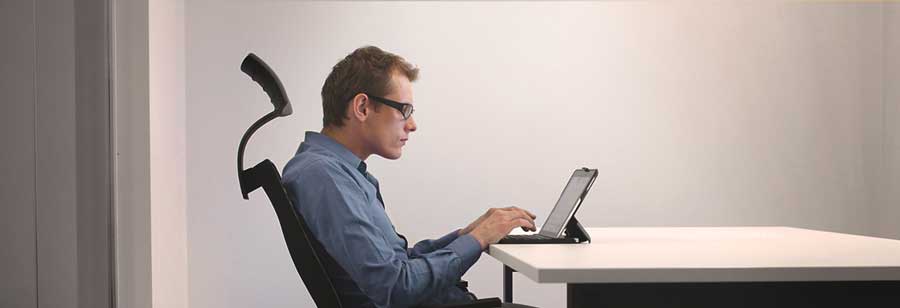The sloth is a medium-sized mammal that moves very rarely—spending the majority of its life in one place feeding off of one tree. It only comes down to use the bathroom about once a week. When the sloth does move, it moves very s l o w l y.
Working in an office can turn humans into similar creatures, tethered to a workstation, only coming out for lunch or bathroom breaks. Regardless which perch you call home, a sedentary life is not a healthy life. Here are four easy ways to break up your workday and make it healthier.
Perform an Ergonomic CheckUp
Improper desk ergonomics can result in neck, back and wrist pain, and over time cause irreparable damage to the body. Prevent pain now and damage later by performing an ergonomic checkup on your desk and work area.
 |
Ergonomic Checkup:
- Head is level or bent slightly forward, forward facing and balanced.
- Shoulders are relaxed, and upper arms hang normally at the side of the body
- Hands, wrists, and forearms are straight, in-line and roughly parallel to the floor.
- Back is fully supported with appropriate lumbar support when sitting vertical or leaning back slightly
- Elbows stay in close to the body and are bent between 90 and 120 degrees.
- Knees are about the same height as the hips with the feet slightly forward.
- Thighs and hips are supported by a well-padded seat and parallel to the floor.
- Feet are fully supported by the floor. A footrest may be used if the desk height is not adjustable.
|
Ergonomic Guidelines by the Occupational Safety and Health Administration (OSHA)
For a more in-depth ergonomic evaluation of your work environment, check out
OSHA’s Computer Workstation eTool.
Take Many Mini-Breaks
Taking short breaks throughout the day could be better at preventing damage from desk sloth syndrome than conventional break schedules. A study by the National Institute for Occupational Safety and Health (NIOSH) found discomfort and eyestrain decreased when computer workers took four five-minute "mini-breaks" throughout their workday. Other studies show that workers who take short breaks increase productivity.
Take a mini-break on the hour to rest your eyes and roll your wrists. Turn away from your screen and focus on the farthest thing you can see for 20 seconds. Then focus on something close to you for 20 seconds, and then back at something farther away. Repeat 10 times. To stretch your wrists and prevent carpal tunnel, try
these three wrist exercises from WebMD.
Take Your Breaks Outside
Use your longer breaks as an opportunity to go outside and walk. Walking improves concentration, focus and attention span, reduces stress and improves your overall cardiovascular health. Bundled with the additional health benefits of fresh air and sunshine, walking outside makes your workday extra healthy.
While aiming for 10,000 steps a day can feel daunting, challenge yourself to see how many steps you can get in during your allotted break time. Remember, just 10 steps is more than you were doing before and can go a long way to preventing desk sloth syndrome. Can’t go outside during your break? Walk around inside your building, or check out these exercises you can do at your desk.
Keep a Water Bottle On Your Desk
Proper hydration increases energy, alertness, concentration, and productivity, fights fatigue and improves mood among many other benefits. And, not any old liquid will do. Harness the power of water, nature’s best hydrator, and make your workday healthier by keeping a water bottle on your desk.
A customized guide of reference for water intake by the Institute of Medicine recommends women drink about nine cups a day and men drink 13 cups. Make it a priority to drink your water bottle dry 3-4 times during the day. Have trouble remembering to drink? Put a sticky note on your monitor or program your phone to remind you to drink up!
References
110 Surprising Benefits of a 10-Minute Walk. WiseBread.com. Accessed on July 27, 2015. http://www.wisebread.com/10-surprising-benefits-of-a-10-minute-walk
2A Formula for Perfect Productivity: Work for 52 Minutes, Break for 17. TheAtlantic.com. Accessed on August 3, 2015. http://www.theatlantic.com/business/archive/2014/09/science-tells-you-how-many-minutes-should-you-take-a-break-for-work-17/380369/
3Computer Eye Strain: 10 Steps for Relief. AllAboutVision.com. Accessed on August 3, 2015. http://www.allaboutvision.com/cvs/irritated.htm
4Computer Workstation Checklist Evaluation. Osha.gov. Accessed on July 27, 2015. https://www.osha.gov/SLTC/etools/computerworkstations/checklist_evaluation.html
5Good Working Positions. Osha.gov. Accessed on July 27, 2015. https://www.osha.gov/SLTC/etools/computerworkstations/positions.html
6Intro to H20: The Basics. AdventistRisk.org/Solutions. Accessed on July 27, 2015. http://adventistrisk.org/prevention-resources/solutions-newsletter/august-2014/intro-to-h2o-the-basics
7Office ergonomics: Your how-to guide. MayoClinic.org. Accessed on July 27, 2015. http://www.mayoclinic.org/healthy-lifestyle/adult-health/in-depth/office-ergonomics/art-20046169
8Rest Breaks for Computer Operators. Labour.gov.on.ca. Accessed on August 3, 2015. http://www.labour.gov.on.ca/english/hs/pubs/gl_restbreaks.php
9Sloth. Wikipedia.org. Accessed on July 27, 2015. https://en.wikipedia.org/wiki/Sloth
10Strategic Rest Breaks Reduce VDT Discomforts Without Impairing Productivity, Niosh, Study Finds. CDC.gov. Accessed on August 3, 2015. http://www.cdc.gov/niosh/updates/restbrks.html
11Stretching Exercises to Help Prevent Carpal Tunnel Syndrome. WebMD.com. Accessed on August 3, 2015. http://www.webmd.com/pain-management/carpal-tunnel/stretching-exercises-for-preventing-carpal-tunnel-syndrome
12Study Finds Nearly Half of Americans Not Drinking Enough Water. ChicagoTribune.com. Accessed on July 27, 2015. http://articles.chicagotribune.com/2013-06-05/health/ct-x-0605-drinking-water-20130605_1_dietary-guidelines-much-water-drinking-water
13The Solution: Fitness Breaks. MayoClinic.org. Accessed July 27, 2015. http://www.mayoclinic.org/healthy-lifestyle/adult-health/in-depth/office-stretches/art-20046041?pg=2
14When, How, and How Often to Take a Break. Inc.com. Accessed August 3, 2015. http://www.inc.com/neil-patel/when-how-and-how-often-to-take-a-break.html



